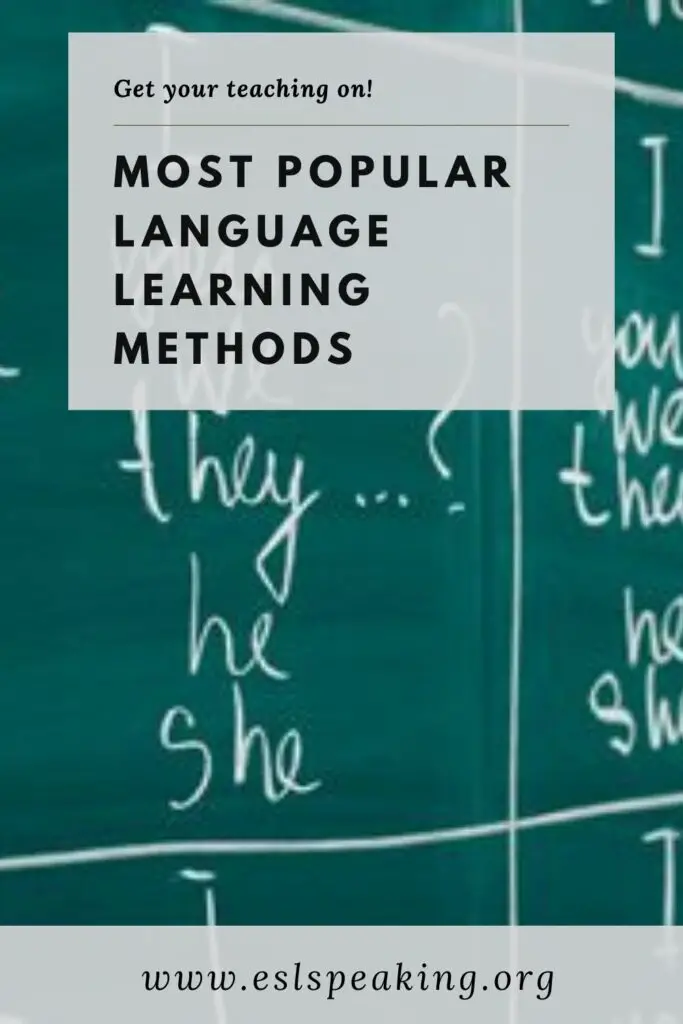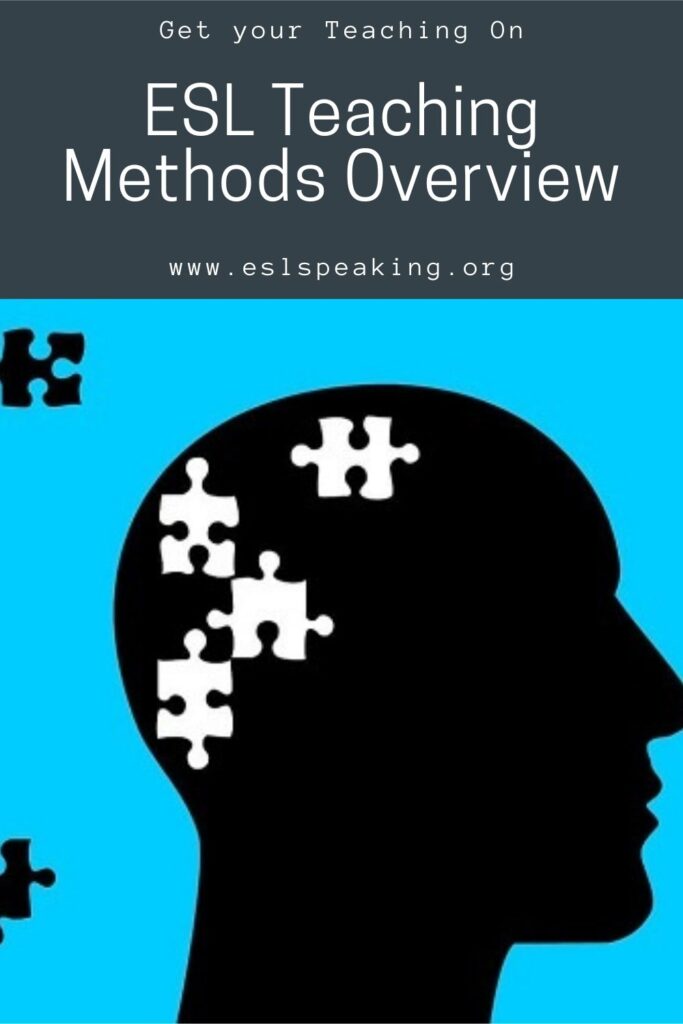Teaching a foreign language can be a challenging but rewarding job that opens up entirely new paths of communication to students. It’s beneficial for teachers to have knowledge of the many different language learning techniques including ESL teaching methods so they can be flexible in their instruction methods, adapting them when needed.
Keep on reading for all the details you need to know about the most popular foreign language teaching methods. Some of the ESL pedagogy ideas covered are the communicative approach, total physical response, the direct method, task-based language learning, suggestopedia, grammar-translation, the audio-lingual approach and more.

Language teaching methods
Most Popular Approaches and Methods in Language Teaching
Here’s a helpful rundown of the most common language teaching methods and ESL teaching methods. You may also want to take a look at this: Foreign language teaching philosophies.
#1: The Direct Method
In the direct method ESL, all teaching occurs in the target language, encouraging the learner to think in that language. The learner does not practice translation or use their native language in the classroom. Practitioners of this method believe that learners should experience a second language without any interference from their native tongue.
Instructors do not stress rigid grammar rules but teach it indirectly through induction. This means that learners figure out grammar rules on their own by practicing the language. The goal for students is to develop connections between experience and language. They do this by concentrating on good pronunciation and the development of oral skills.
This method improves understanding, fluency, reading, and listening skills in our students. Standard techniques are question and answer, conversation, reading aloud, writing, and student self-correction for this language learning method. Learn more about this method of foreign language teaching in this video:
#2: Grammar-Translation
With this method, the student learns primarily by translating to and from the target language. Instructors encourage the learner to memorize grammar rules and vocabulary lists. There is little or no focus on speaking and listening. Teachers conduct classes in the student’s native language with this ESL teaching method.
This method’s two primary goals are to progress the learner’s reading ability to understand literature in the second language and promote the learner’s overall intellectual development. Grammar drills are a common approach. Another popular activity is translation exercises that emphasize the form of the writing instead of the content.
Although the grammar-translation approach was one of the most popular language teaching methods in the past, it has significant drawbacks that have caused it to fall out of favour in modern schools. Principally, students often have trouble conversing in the second language because they receive no instruction in oral skills.
#3: Audio-Lingual
The audio-lingual approach encourages students to develop habits that support language learning. Students learn primarily through pattern drills, particularly dialogues, which the teacher uses to help students practice and memorize the language. These dialogues follow standard configurations of communication.
There are four types of dialogues utilized in this method:
- Repetition, in which the student repeats the teacher’s statement exactly
- Inflection, where one of the words appears in a different form from the previous sentence (for example, a word may change from the singular to the plural)
- Replacement, which involves one word being replaced with another while the sentence construction remains the same
- Restatement, where the learner rephrases the teacher’s statement
This technique’s name comes from the order it uses to teach language skills. It starts with listening and speaking, followed by reading and writing, meaning that it emphasizes hearing and speaking the language before experiencing its written form. Because of this, teachers use only the target language in the classroom with this TESOL method.
Many of the current online language learning apps and programs closely follow the audio-lingual language teaching approach. It is a nice option for language learning remotely and/or alone, even though it’s an older ESL teaching method.
#4: Structural Approach
Proponents of the structural approach understand language as a set of grammatical rules that should be learned one at a time in a specific order. It focuses on mastering these structures, building one skill on top of another, instead of memorizing vocabulary. This is similar to how young children learn a new language naturally.
An example of the structural approach is teaching the present tense of a verb, like “to be,” before progressing to more advanced verb tenses, like the present continuous tense that uses “to be” as an auxiliary.
The structural approach teaches all four central language skills: listening, speaking, reading, and writing. It’s a technique that teachers can implement with many other language teaching methods.
Most ESL textbooks take this approach into account. The easier-to-grasp grammatical concepts are taught before the more difficult ones. This is one of the modern language teaching methods.

Most popular methods and approaches and language teaching
#5: Total Physical Response (TPR)
The total physical response method highlights aural comprehension by allowing the learner to respond to basic commands, like “open the door” or “sit down.” It combines language and physical movements for a comprehensive learning experience.
In an ordinary TPR class, the teacher would give verbal commands in the target language with a physical movement. The student would respond by following the command with a physical action of their own. It helps students actively connect meaning to the language and passively recognize the language’s structure.
Many instructors use TPR alongside other methods of language learning. While TPR can help learners of all ages, it is used most often with young students and beginners. It’s a nice option for an English teaching method to use alongside some of the other ones on this list.
An example of a game that could fall under TPR is Simon Says. Or, do the following as a simple review activity. After teaching classroom vocabulary, or prepositions, instruct students to do the following:
- Pick up your pencil.
- Stand behind someone.
- Put your water bottle under your chair.
- Etc.
Are you on your feet all day teaching young learners? Consider picking up some of these teacher shoes.
#6: Communicative Language Teaching (CLT)
These days, CLT is by far one of the most popular approaches and methods in language teaching. Keep reading to find out more about it.
This method stresses interaction and communication to teach a second language effectively. Students participate in everyday situations they are likely to encounter in the target language. For example, learners may practice introductory conversations, offering suggestions, making invitations, complaining, or expressing time or location.
Instructors also incorporate learning topics outside of conventional grammar so that students develop the ability to respond in diverse situations.
- Amazon Kindle Edition
- Bolen, Jackie (Author)
- English (Publication Language)
- 211 Pages - 12/21/2022 (Publication Date)
CLT teachers focus on being facilitators rather than straightforward instructors. Doing so helps students achieve CLT’s primary goal, learning to communicate in the target language instead of emphasizing the mastery of grammar.
Role-play, interviews, group work, and opinion sharing are popular activities practiced in communicative language teaching, along with games like scavenger hunts and information gap exercises that promote student interaction.
Most modern-day ESL teaching textbooks like Four Corners, Smart Choice, or Touchstone are heavy on communicative activities.
#7: Natural Approach
This approach aims to mimic natural language learning with a focus on communication and instruction through exposure. It de-emphasizes formal grammar training. Instead, instructors concentrate on creating a stress-free environment and avoiding forced language production from students.
Teachers also do not explicitly correct student mistakes. The goal is to reduce student anxiety and encourage them to engage with the second language spontaneously.
Classroom procedures commonly used in the natural approach are problem-solving activities, learning games, affective-humanistic tasks that involve the students’ own ideas, and content practices that synthesize various subject matter, like culture.
#8: Task-Based Language Teaching (TBL)
With this method, students complete real-world tasks using their target language. This technique encourages fluency by boosting the learner’s confidence with each task accomplished and reducing direct mistake correction.
Tasks fall under three categories:
- Information gap, or activities that involve the transfer of information from one person, place, or form to another.
- Reasoning gap tasks that ask a student to discover new knowledge from a given set of information using inference, reasoning, perception, and deduction.
- Opinion gap activities, in which students react to a particular situation by expressing their feelings or opinions.
Popular classroom tasks practiced in task-based learning include presentations on an assigned topic and conducting interviews with peers or adults in the target language. Or, having students work together to make a poster and then do a short presentation about a current event. These are just a couple of examples and there are literally thousands of things you can do in the classroom. In terms of ESL pedagogy, this is one of the most popular modern language teaching methods.
It’s considered to be a modern method of teaching English. I personally try to do at least 1-2 task-based projects in all my classes each semester. It’s a nice change of pace from my usually very communicative-focused activities.
One huge advantage of TBL is that students have some degree of freedom to learn the language they want to learn. Also, they can learn some self-reflection and teamwork skills as well.
#9: Suggestopedia Language Learning Method
This approach and method in language teaching was developed in the 1970s by psychotherapist Georgi Lozanov. It is sometimes also known as the positive suggestion method but it later became sometimes known as desuggestopedia.
Apart from using physical surroundings and a good classroom atmosphere to make students feel comfortable, here are some of the main tenants of this second language teaching method:
- Deciphering, where the teacher introduces new grammar and vocabulary.
- Concert sessions, where the teacher reads a text and the students follow along with music in the background. This can be both active and passive.
- Elaboration where students finish what they’ve learned with dramas, songs, or games.
- Introduction in which the teacher introduces new things in a playful manner.
- Production, where students speak and interact without correction or interruption.

TESOL methods and approaches
#10: The Silent Way
The silent way is an interesting ESL teaching method that isn’t that common but it does have some solid footing. After all, the goal in most language classes is to make them as student-centred as possible.
In the Silent Way, the teacher talks as little as possible, with the idea that students learn best when discovering things on their own. Learners are encouraged to be independent and to discover and figure out language on their own.
Instead of talking, the teacher uses gestures and facial expressions to communicate, as well as props, including the famous Cuisenaire Rods. These are rods of different colours and lengths.
Although it’s not practical to teach an entire course using the silent way, it does certainly have some value as a language teaching approach to remind teachers to talk less and get students talking more!
#11: Functional-Notional Approach
This English teaching method first of all recognizes that language is purposeful communication. The reason people talk is that they want to communicate something to someone else.
Parts of speech like nouns and verbs exist to express language functions and notions. People speak to inform, agree, question, persuade, evaluate, and perform various other functions. Language is also used to talk about concepts or notions like time, events, places, etc.
The role of the teacher in this second language teaching method is to evaluate how students will use the language. This will serve as a guide for what should be taught in class. Teaching specific grammar patterns or vocabulary sets does play a role but the purpose for which students need to know these things should always be kept in mind with the functional-notional Approach to English teaching.
#12: The Bilingual Method
The bilingual method uses two languages in the classroom, the mother tongue and the target language. The mother tongue is briefly used for grammar and vocabulary explanations. Then, the rest of the class is conducted in English. Check out this video for some of the pros and cons of this method:
#13: The Test Teach Test Approach (TTT)
This style of language teaching is ideal for directly targeting students’ needs. It’s best for intermediate and advanced learners. Definitely don’t use it for total beginners!
There are three stages:
- A test or task of some kind that requires students to use the target language.
- Explicit teaching or focus on accuracy with controlled practice exercises.
- Another test or task is to see if students have improved in their use of the target language.
Want to give it a try? Find out what you need to know here:
#14: Community Language Learning
In Community Language Learning, the class is considered to be one unit. They learn together. In this style of class, the teacher is not a lecturer but is more of a counsellor or guide.
In general, there is no set lesson for the day. Instead, students decide what they want to talk about. They sit in the a circle, and decide on what they want to talk about. They may ask the teacher for a translation or for advice on pronunciation or how to say something.
The conversations are recorded, and then transcribed. Students and teacher can analyze the grammar and vocabulary, as well as subject related content.
While community language learning may not comprehensively cover the English language, students will be learning what they want to learn. It’s also student-centred to the max. It’s perhaps a nice change of pace from the usual teacher-led classes, but it’s not often seen these days as the only method of teaching a class.M
#15: The Situational Approach
This approach loosely falls under the behaviourism view of language as habit formation. The situational approach to teaching English was popular in England, starting in the 1930s. Find out more about it:
Language Teaching Approaches FAQs
There are a number of common questions that people have about second or foreign language teaching and learning. Here are the answers to some of the most popular ones.
What is language teaching approaches?
A language teaching approach is a way of thinking about teaching and learning. An approach produces methods, which is the way of teaching something, in this case, a second or foreign language using techniques or activities.
What are method and approach?
Method and approach are similar but there are some key differences. An approach is the way of dealing with something while a method involves the process or steps taken to handle the issue or task.
What is presentation practice production?
How many approaches are there in language learning?
Throughout history, there have been just over 30 popular approaches to language learning. However, there are around 10 that are most widely known including task-based learning, the communicative approach, grammar-translation and the audio-lingual approach. These days, the communicative approach is all the rage.
What is the best method of English language teaching?
It’s difficult to choose the best single approach or method for English language teaching as the one used depends on the age and level of the students as well as the material being taught. Most teachers find that a mix of the communicative approach, audio-lingual approach and task-based teaching works well in most cases.
What is micro teaching?
What are the most effective methods of learning a language?
The most effective methods for learning a language really depends on the person, but in general, here are some of the best options: total immersion, the communicative approach, extensive reading, extensive listening, and spaced repetition.
The Modern Methods of Teaching English
There are several modern methods of teaching English that focus on engaging students and making learning more interactive and effective. Some of these methods include:
Communicative Language Teaching (CLT)
This approach emphasizes communication and interaction as the main goals of language learning. It focuses on real-life situations and encourages students to use English in meaningful contexts.
Task-Based Learning (TBL)
TBL involves designing activities or tasks that require students to use English to complete a specific goal or objective. This approach helps students develop language skills while focusing on the task at hand.
Technology-Enhanced Learning
Using technology such as computers, tablets, and smartphones can make learning more engaging and interactive. Online resources, apps, and educational games can be used to supplement traditional teaching methods.
Flipped Classroom
In a flipped classroom, students learn new material at home through videos or online resources, and then use class time for activities, discussions, and practice exercises. This approach allows for more individualized learning and interaction in the classroom.
Project-Based Learning (PBL)
PBL involves students working on projects or tasks that require them to use English in a real-world context. This approach helps students develop critical thinking and problem-solving skills while improving their language abilities.
Content and Language Integrated Learning (CLIL)
CLIL involves teaching subjects such as science or history in English, rather than teaching English as a separate subject. This approach helps students learn English while also learning about other subjects.
Gamification
Using game elements such as points, badges, and leaderboards can make learning English more fun and engaging. Educational games can help students practice language skills in a playful and interactive way.
These modern methods of teaching English focus on making learning more student-centered, interactive, and engaging, leading to better outcomes for students.
Have your say about Approaches and Methods in Language Teaching
What’s your top pick for a language teaching method? Is it one of the options from this list or do you have another one that you’d like to mention? Leave a comment below and let us know what you think. We’d love to hear from you. And whatever approach or method you use, you’ll want to check out these top 1o tips for new English teachers.
Also, be sure to give this article a share on Facebook, Pinterest, or Twitter. It’ll help other busy teachers, like yourself, find this useful information about approaches and methods in language teaching and learning.
Last update on 2025-05-31 / Affiliate links / Images from Amazon Product Advertising API






This is wonderful, I have learned a lot!
You’re welcome!
What year did you publish this please?
Recently! Only a few months ago.
2007
Wonderful! Thank you for sharing such useful information. I have learned a lot from them. Thank you!
I am so grateful. Thanks for sharing your kmowledge.
Hi thank you so much for this amazing article. I just wanted to confirm/ask is PPP one of the methods of teaching ESL if so was there a reason it wasn’t included in the article(outdated, not effective etc.?).
PPP is more of a subset of these other ones and not an approach or method in itself.
Good explanation, understandable and clear. Congratulations
That’s good, very short but clear…👏🏾👏🏾👏🏾👏🏾👏🏾
I meant the naturalistic approach
This is amazing! Thank you for writing this article, it helped me a lot. I hoped this will reach more people so I will definitely recommend this to others.
Thank you, sir! I just used this article in my PPT presentation at my Post Grad School.
More articles from you!
I think this useful because it is teaching me a lot about english. Thank you bro!
😀👍